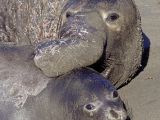1. Seals are of two types: eared seals (sea lions and fur seals) and true seals (earless seals). Scientists thought the eared seals and walruses had a common origin with bears and dogs from an ancestors that lived on northern Pacific shores, while genuine seals had a common origin with otters, in the northern Atlantic, 14 million years ago. Still, DNA analyzes showed that all seals have a common origin.
2. Sea lions can gallop with 25-30 km (15.5-19 mi) per hour, being much faster on land than humans! Instead, genuine seals just crawl like caterpillars on the ground, with the rear limbs placed behind their body, while eared seals have rear limbs placed forward, beneath the body. Genuine seals often spend 80-90% of their time at sea underwater, while eared seals spend a lot of time in beach colonies.
The rear limbs of the eared seals act like a rudder (the fore limbs are used for "flying" underwater), while genuine seals use them as propellers).
3. Sea lions dive 2 minutes on average, while a maximum dive lasts 12 minutes, down to 70-270 m (230-900 ft). Genuine seals ashame them: an average dive lasts 20 minutes. The Weddell seal can dive to 700 m (2,670 ft) for over one hour searching for fish and cephalopods. Still, elephant seals can spend up to 80 minutes at depths of more than 1,500 m (5,000 ft), while average dives last only 25-30 minutes at depths of about 500 m (1,640 ft).
4. Eared seals are famous for the colonies where they form harems. Amongst the true seals, only the elephant seals form similarly large harems. The other species too form harems of 30-50 females, with beach owners, only that their colonies are looser.
Male sea lions can be 5 times larger than females. Elephant seal males are 8 times larger than females. In other genuine seals, the differences between the sexes are smaller.
5. Steller sea lion (Eumatopias jubatus) is the largest sea lion: males can be 3 m (10 ft) long, weighing 1 tonne. A dwarf, compared to the largest genuine seal, the elephant seal. Bulls of the elephant seals reach a length of 18 ft (5.5 m) and a weight of 5,000 lb (2,270 kg), and the record weighed 5000 kg (11,000 lb) (as much as an average African bull elephant) and measured 6.9 m (22.5 ft) in length. The "trunk" of the males can be 45 cm (1.5 ft) long!
6. Genuine seal cubs use to be white in most polar species, as they are usually born on ice, and this is a protective color. The milk of the genuine seal is made 50 % (!) of fat (15 times more than in cow's milk), so the cub gains 2-3 kg (4.5-7 pounds) daily. A 14 kg (30 pounds) pup of gray seal grows up to 41 kg (85 pounds) in 3 weeks, while a harp seal, which gives birth during the winter in the northern Atlantic has a 9-10 kg (20-22 pounds) pup that grows to 45 kg (100 pounds) in 2 weeks and 50 kg (110 pounds) in 3 weeks (in colder clime, the pup of the harp seal has to accumulate faster a fatty protective underskin layer).
7. Seals shiver if exposed to cold air, but not when diving in chilly water. This produces a decrease in the temperature of the body (which turns hypothermic), allowing it to better cope with a lack of oxygen (hypoxia) and minimize brain damage that could result from long dives.
Hypothermia causes a slower metabolism and lowered oxygen requirements, which extends the dive time. Moreover, seals can store four times more oxygen in their blood and muscles than humans. The seal's brain cools by 3? C during the dives. The cooler brain requires less energy and oxygen and reduces the chance of damage caused by hypoxia.

 14 DAY TRIAL //
14 DAY TRIAL // 
